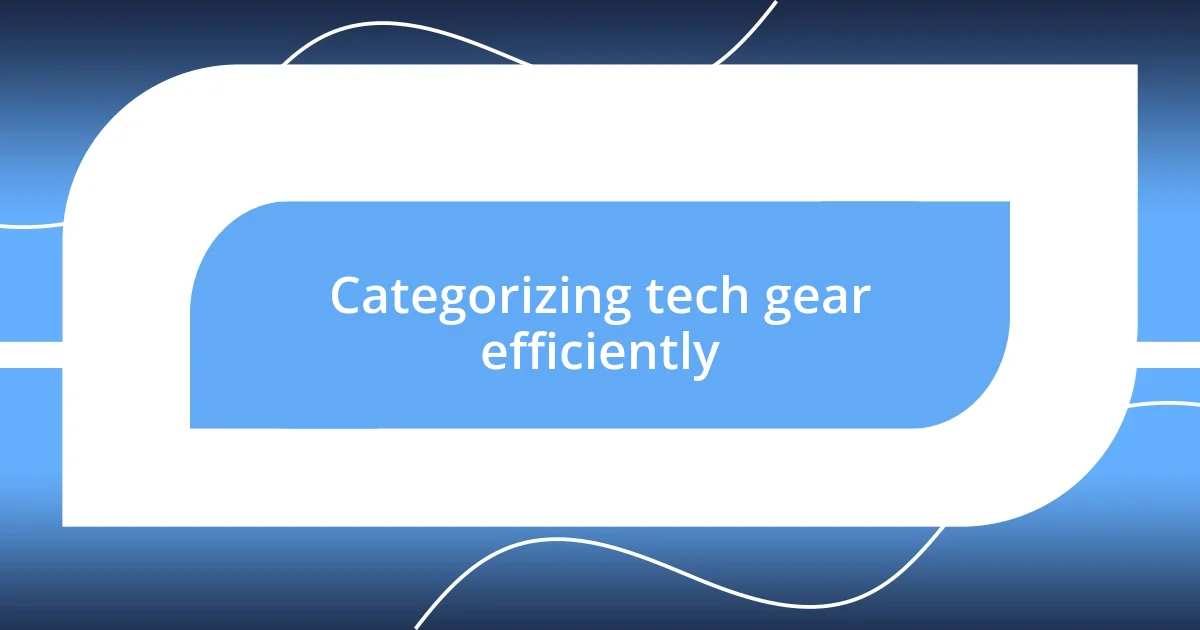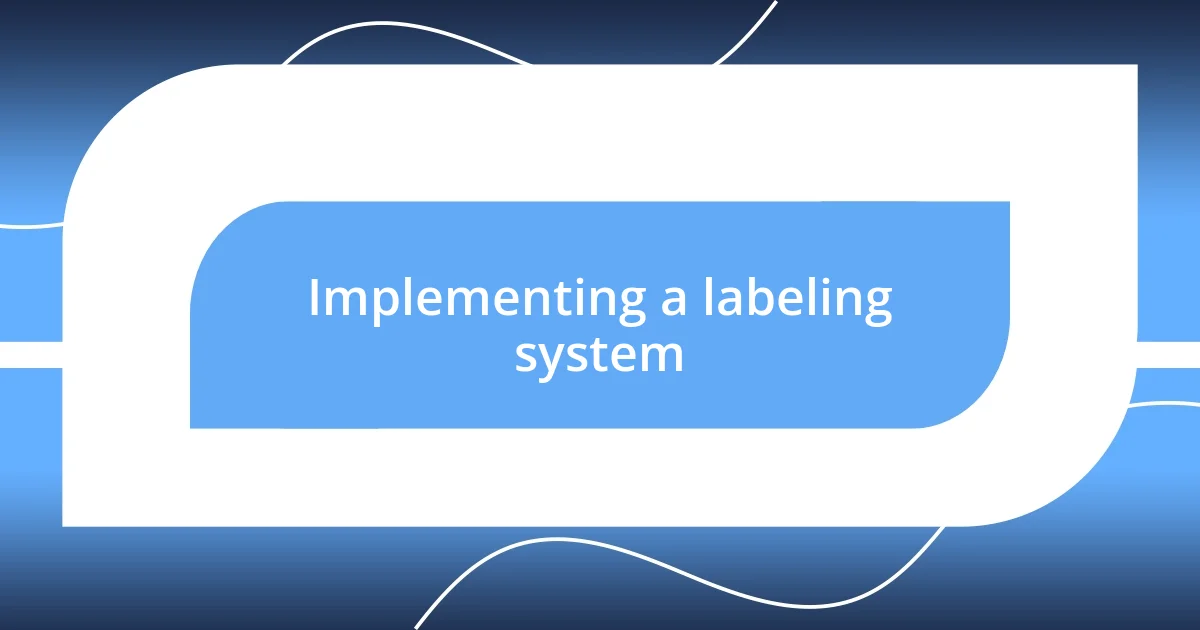Key takeaways:
- Assess and simplify your tech gear by focusing on essential devices, avoiding clutter, and letting go of unnecessary items.
- Organize your workspace effectively with categorization, labeling, and appropriate storage solutions to enhance functionality and efficiency.
- Maintain ongoing organization through regular reviews, personal motivation, and thoughtful evaluation of future gear additions to ensure compatibility and purpose.

Understanding your tech gear needs
Understanding your tech gear needs starts with reflecting on how you use your devices daily. When I first took stock of my collection, I realized that some gadgets were gathering dust while others were nearly always in my hands. Have you ever felt overwhelmed by the sheer number of cables and devices? It’s easy to forget that less can often be more.
Think about what tasks are essential to your routine. For instance, I discovered that while I loved the allure of the latest camera gear, my smartphone was all I really needed to capture moments. This realization not only simplified my setup but also saved me money. What would you prioritize—functionality or the latest trends?
Finally, don’t overlook the emotional connection we often have with our tech. I remember clinging to an old laptop because it held memories of countless late-night projects. Letting go wasn’t easy, but recognizing its limitations helped me make better choices for my productivity. What pieces of tech have you hesitated to part with, and is it time to reassess their place in your life?

Assessing space and storage options
After you’ve pinpointed your tech needs, it’s essential to take stock of your available space. I learned the hard way that clutter can quickly derail my productivity. I vividly remember a time when my workspace transformed into a chaotic maze of cables and devices. It felt stifling! I took a step back to assess not just what I had, but where it was all going to fit.
To maximize your storage, consider these options:
- Shelving Units: Great for keeping devices off your desk and creating vertical storage.
- Drawer Organizers: Help keep smaller gadgets and cables tidy and easily accessible.
- Cable Management Solutions: Velcro ties or labeled bags can help prevent tangling and make it easier to find what you need.
- Storage Bins: Use bins for items you don’t access daily but still want to keep.
By analyzing the space I had, I was able to create a functional workspace that complemented my workflow and cleared my mind. It’s amazing how a little organization can lead to a calmer environment. How do your surroundings influence your tech setup?

Categorizing tech gear efficiently
When it comes to categorizing tech gear efficiently, I found it helpful to create distinct groups based on usage. For example, I categorize my gear into daily essentials, photography equipment, and office supplies. This method not only aids in quick retrieval but also makes it easier to evaluate what I truly need. Have you ever rummaged through drawers, hoping to find your headphones or a charging cable buried under heaps of unused gadgets? I certainly have, and it led to frustrating moments of wasted time.
Next, I discovered that using labels can significantly enhance organization. I started labeling my bins and drawers, ensuring that each category was easily identifiable. A simple label for “Photography” or “Cables” keeps everything in its place. It’s a small step that pays off in the long run, saving me from messy searches. Isn’t it satisfying when everything has its own spot?
I also encourage reassessing these categories regularly. As my tech needs evolve, I update my organization system accordingly. For instance, I recently let go of an old tablet that I hadn’t used in months, freeing up space for a new Bluetooth speaker. This ongoing process keeps my gear relevant and functional. How often do you check in on your tech organization? Staying proactive can lead to smoother workflows and less frustration.
| Category | Examples |
|---|---|
| Daily Essentials | Smartphone, Laptop, Charger |
| Photography Equipment | Camera, Lenses, Tripod |
| Office Supplies | Notebooks, Pens, Printer |
| Cables | USB Cables, Chargers, Earphones |

Choosing the right organizing tools
Choosing the right organizing tools can make all the difference in how effectively I manage my tech gear. For me, the first tool to consider was a good set of drawer organizers. I remember getting frustrated searching for that elusive charging cable, only to find it tangled up in a jumble of other cords. Once I installed compartmentalized drawer inserts, I felt an immediate weight lifted off my shoulders. Each cable found its rightful place, making my daily routine smoother and more efficient. Have you ever thought about how much time could be saved just by using the right organizing tools?
Beyond just drawer organizers, I’ve found that investing in a solid cord management system is crucial. I opted for adhesive cable clips that keep everything neat and accessible, rather than hidden away. There’s something satisfying about seeing clean lines and ordered cables rather than a chaotic web of electronics vying for attention. Doesn’t it feel great to slide into work without the distraction of clutter?
Lastly, I also recommend considering the size and portability of your organizing tools. After an incident where I had to lug a bulky storage bin around to find my gear, I realized that compact, stackable bins were a game-changer. Choosing lightweight containers allowed me to easily rearrange my setup whenever inspiration struck. As you select your organizing tools, what features do you find most important for enhancing your workflow?

Implementing a labeling system
Implementing a labeling system transformed how I navigate my tech gear. Initially, I used plain white labels with a black marker, and while functional, they lacked personality. After a little experimenting, I discovered color-coded labels—green for daily essentials and blue for photo gear. This vibrant approach not only added a splash of color to my workspace but also made finding items super quick. Have you ever thought about how a simple visual cue can make a chaotic space feel more ordered?
I recall one chaotic afternoon when I was preparing for a shoot. I spent nearly half an hour just trying to locate my lens. That’s when I realized the importance of clarity in labeling. I quickly labeled each bin not just with the category but also with the specific items inside. This way, I could immediately see where my lens was stored without pawing through several boxes. Isn’t it liberating to eliminate that wasted time?
Moreover, I found that regularly updating my labels is equally essential. As I acquire new gadgets, I make a habit of re-assessing and adjusting the labels to ensure they reflect my current needs. I’ll never forget the time I overlooked a new gadget because its label hadn’t been updated. This led to a minor disaster during a project! Have you checked whether your labels are still relevant lately? Keeping your system fresh is crucial for maintaining an organized and efficient environment.

Maintaining organization over time
Maintaining organization over time is an ongoing process that really requires dedication. I’ve learned that it’s not just about setting up a system; it’s about sticking to it. For instance, I used to let cords get messy again after I was in a hurry to grab a device. Now, I make it a point to return each item to its designated place, and honestly, that small effort has paid off enormously. Isn’t it interesting how a few seconds of tidying can save so much hassle later on?
Another key aspect I’ve discovered is holding periodic reviews of my organization system. I set aside a little time every couple of months to assess what’s working and what isn’t. Just the other week, I found myself getting annoyed by a particular pouch that held rarely-used accessories. Upon reflection, I decided to relocate those items to a less prominent spot. It felt freeing to make that adjustment—like clearing my mental clutter, too. Have you ever thought about how these small evaluations can lead to big improvements?
Additionally, I’ve realized that keeping my organization system appealing and functional plays a huge role in its longevity. I’ve added little motivational elements, such as quotes on sticky notes near my workspace, reminding me why organization matters. This shift has fostered a deeper emotional connection to my setup, making me want to maintain it more actively. When was the last time you infused your organization routine with something personal? It can make all the difference in how committed you feel to sustaining your organized space.

Tips for future gear additions
When considering future gear additions, I always recommend evaluating how each new item fits into my existing system. For instance, when I was drawn to a shiny new microphone, I stopped to think about whether it would genuinely enhance my workflow or just add to the clutter. I believe that every piece of tech should serve a purpose—does this resonate with your own experience?
I’ve also found it helpful to maintain a wishlist of potential gear, rather than impulsively purchasing. Early on, I acted on impulse and ended up with duplicates or gadgets that didn’t meet my needs. This was frustrating! Now, I take the time to research each item thoroughly. By weighing pros and cons and visualizing their place within my setup, I can make more informed decisions. Have you ever rushed into a tech purchase and regretted it later?
Lastly, never underestimate the importance of compatibility. I remember the excitement of getting a new hard drive, only to realize it didn’t sync well with my software. That was a frustrating experience! By considering how any future gear addition will integrate with my current tech ecosystem, I set myself up for success. How often do you think about compatibility before making a tech investment? Ensuring everything works harmoniously not only saves time but also enhances my overall efficiency.













